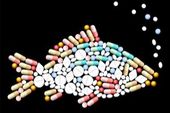Pharmaceutical dumping poses risks to wildlife
What happens when the drugs used to treat humans and animals are disposed?
Scientific studies published Monday in a special issue of the journal reveal that pharmaceuticals, when flushed into land and water ecosystems, could pose risks to wildlife, from altering species' behavior to changing fertility rates to death.
Pharmaceuticals can enter wild environments through a variety of routes, including dumping from drug manufacturers, as well as sewage.
"Global pharmaceutical consumption is rising with the growing and aging human population and more intensive food production," writes Kathryn E. Arnold of the University of York in the UK and colleagues. "Recent studies have revealed pharmaceutical residues in a wide range of ecosystems and organisms." Despite the scope of the issue, the effects of pharmaceuticals in the environment are little researched and understood.But in the research series published Monday, scientists uncover a broad spectrum of impacts.

© www.commondreams.org
Water-breeding amphibians are susceptible to the impacts of water-borne pharmaceuticals.
Wild starlings, exposed to the anti-depressant fluoxetine, undergo changes in behavior and physiology, including shifts in feeding frequency. At the Experimental Lakes Area in northwestern Ontario, Canada, estrogen from birth control pills was found to alter the entire ecosystem of the lake, leading to a decline in trout, an increase in insects, and the elimination of fathead minnows. Another study finds that amphibians, because most of them breed in water, "may therefore be exposed to water-borne pharmaceuticals during critical phases of the reproductive cycle," posing risks to fertility.
Researchers Anette Küster and Nicole Adler, of Germany's Federal Environment Agency, point out, "For human medicinal products, hormones, antibiotics, analgesics, antidepressants and antineoplastics indicated an environmental risk. For veterinary products, hormones, antibiotics and parasiticides were most often discussed as being environmentally relevant."
They argue that more research and regulation is needed: "In order to minimize the quantity of pharmaceuticals in the environment [legislation and research] should aim to (i) improve the existing legislation for pharmaceuticals, (ii) prioritize pharmaceuticals in the environment and (iii) improve the availability and collection of pharmaceutical data."
Comment: Once again we are messing with the trajectory of natural evolution as our global society more and more seeks its solutions to human problems through pHARMa. The waterways of industrialized nations are flooded with the "miracles" of modern living. Designed to resist degradation, pharmaceuticals, veterinary and illegal drugs along with detergents, cosmetics, fragrances and sunscreens (not to mention the broad spectrum of industrial wastes) are found anywhere human activity connects to rivers, lakes or coastal waters causing their inhabitants damaged cells, cancer, loss of fertility - be it fish, invertebrates or microscopic life. Landfills also pose similar problems for birds and animals that raid these mountains of human left-overs.
Emerging contaminants are currently unregulated. Thousands of consumer chemicals are on the market with more being developed every day. The way they interact in natural ecosystems is obviously complex. Apparently no one treatment can degrade every compound and too little is being done to solve this problem. The concentrations and ramifications of drug-altering substances in our waterways are only likely to increase unless we find the ways and impetus to revise disposal practices, stem the production of or eliminate unnecessary medications, and clean up the chemical waste to ensure bio-safety for all species. Oddly enough, this just happens to be the best medicine for the survival of humanity as well.



0 reacties:
Post a Comment